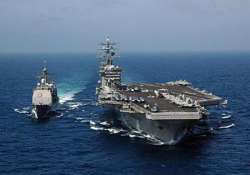Coastal surveillance system launched
Mumbai, Aug 25: Defence Minister A K Antony today inaugurated the Maharashtra cluster of chain of static sensors aimed at proving real time surveillance cover along the coastline.The sensors are operational with radar stations fitted

Mumbai, Aug 25: Defence Minister A K Antony today inaugurated the Maharashtra cluster of chain of static sensors aimed at proving real time surveillance cover along the coastline.
The sensors are operational with radar stations fitted at Tarapur, Korlai, Tolkeshwar and Devgad as part of the chain of static sensors project by the Coast Guard. The project is based on the recommendations made by the group of ministers on reforming the national security system, post Kargil conflict.
Phase one of the project envisages real-time surveillance cover up to 25 nautical miles around the areas of high sensitivity and traffic density along the Indian coastline. The project was expedited after the 26/11 Mumbai terror attacks.
The chain of static sensors is the first of its kind in terms of both expanse and strategic implication and spans 46 locations in the first phase, including sites on the mainland and in Lakshadweep and Minicoy Islands Andaman and Nicobar Islands.
High end surveillance gadgets such as frequency diversity radar, electro-optic sensor, VHF sets and metrological equipment have been installed on either existing light houses or masts erected at each sites.
Data generated by the static sensors at the remote operating stations will come to the Guard regional headquarters which will serve as regional operating centers. The data will also be inter-faced with the Vessel Traffic Management Systems of the major ports and the fishing vessel monitoring system.
The chain of static sensors aims at preventing undetected intrusion of vessels along the Indian coastline.
The sensors are operational with radar stations fitted at Tarapur, Korlai, Tolkeshwar and Devgad as part of the chain of static sensors project by the Coast Guard. The project is based on the recommendations made by the group of ministers on reforming the national security system, post Kargil conflict.
Phase one of the project envisages real-time surveillance cover up to 25 nautical miles around the areas of high sensitivity and traffic density along the Indian coastline. The project was expedited after the 26/11 Mumbai terror attacks.
The chain of static sensors is the first of its kind in terms of both expanse and strategic implication and spans 46 locations in the first phase, including sites on the mainland and in Lakshadweep and Minicoy Islands Andaman and Nicobar Islands.
High end surveillance gadgets such as frequency diversity radar, electro-optic sensor, VHF sets and metrological equipment have been installed on either existing light houses or masts erected at each sites.
Data generated by the static sensors at the remote operating stations will come to the Guard regional headquarters which will serve as regional operating centers. The data will also be inter-faced with the Vessel Traffic Management Systems of the major ports and the fishing vessel monitoring system.
The chain of static sensors aims at preventing undetected intrusion of vessels along the Indian coastline.